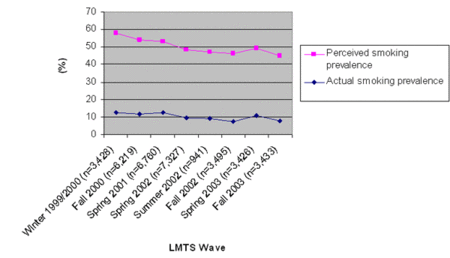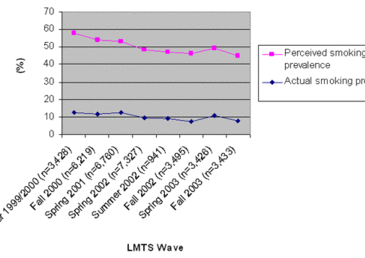Research has shown that some adolescents tend to overestimate smoking among their peers (Sherman, Presson, Chassin, Corty, & Olshavsky, 1983; Tyas & Pederson, 1998). Longitudinal and cross-sectional studies show that such overestimation predicts smoking in the future (Miller & McFarland, 1987; Prentice & Miller, 1996). Anti-smoking campaigns have worked to correct adolescents’ inaccurate perceptions about smoking prevalence; however, there is a paucity of research assessing the effect of these programs. This week’s ASHES reviews a comparison of the TRUTH and the “Think. Don’t Smoke.” (TDS) campaigns’ influence on adolescents’ perceived smoking prevalence.
To evaluate the influence of two anti-smoking public health campaigns, TRUTH and TDS, on youth smoking rates, Davis, Nonnemaker, and Farrelly (2007) analyzed data from eight cross-sectional waves of the Legacy Media Tracking Survey (LMTS), which were conducted between winter 1999 and fall 2003 (response rates = 52.5%, 52.3%, 60.4%, 46.7%, 51.7%, 53.1%, 42.5%, 30.1%, respectively). The TRUTH campaign featured adolescents stating facts about the tobacco industry and the TDS campaign featured adolescents declaring their personal reasons for not smoking. LMTS assessed the extent of adolescents’ (n=35,074; ages 12-7 years) exposure to both antismoking campaigns by confirming (1) exposure to at least one television advertisement, (2) prompted recall of a specific campaign slogan, or (3) unprompted recall of a specific campaign slogan. The survey also asked participants to estimate the prevalence of smoking among their peers, and to report their own smoking behavior.
Linear trend tests indicated a significant decrease in the perception about peer smoking prevalence among adolescents between the first and last LMTS wave (45.4% to 37.5%, p<.05). Figure 1 shows that this decline in perceived smoking prevalence was similar to a significant decrease in actual smoking prevalence among participants during the same period (12.7% to 7.6%, p<.05). Regression analyses indicated that participants who confirmed exposure to the TRUTH campaign in measures (1), (2), or (3) all estimated the smoking prevalence among adolescents to be significantly lower (campaign awareness regression coefficients were 1.4, 1.6, and 1.7 percentage points lower, respectively) than those who were unaware of the campaign (p <.02, p<.03, p<.04, respectively). However, there were no significant differences in the estimation of smoking prevalence between participants who confirmed exposure to the TDS campaign and those who did not.

Figure. Smoking Prevalence Among 12 to 17 Year-Olds. Click image to enlarge.
This study is not without its limitations. The study found statistically significant but clinically small differences due to exposure to the TRUTH campaign, and only for the comparison between first and last wave estimates. This difference might be confounded by the large decline in the response rate at these observation points (i.e., 52.5% to 30.1%).
The results of this investigation indicate that adolescents find actual information about the tobacco industry more compelling than their peers’ personal beliefs. Future research should focus on the components of the TRUTH campaign that have led to the program’s success; developing successful marketing methods to correct adolescents’ magnified perception of smoking prevalence indirectly might help to reduce future smoking behavior.
–Sara Kaplan.
References
Davis, K. C., Nonnemaker, J. M., & Farrelly, M. C. (2007). Association between national smoking prevention campaigns and perceived smoking prevalence among youth in the United States. Journal of Adolescent Health, 41, 430-436.
Miller, D. T., & McFarland, C. (1987). Pluralistic ignorance: When similarity is interpreted as dissimilarity. Journal of Personality and Social Psychology, 53, 298-305.
Prentice, D. A., & Miller, D. T. (1996). Pluralistic ignorance and the perpetuation of social norms by unwitting actors. Advances in Experimental Social Psychology 28, 161-209.
Sherman, S. J., Presson, C. C., Chassin, L., Corty, E., & Olshavsky, R. (1983). The false consensus effect in estimates of smoking prevalence: Underlying mechanisms. Personality and Social Psychology Bulletin, 9, 197-207.
Tyas, S. L., & Pederson, L. L. (1998). Psychosocial factors related to adolescent smoking: A critical review of the literature. Tobacco Control, 7, 409-420.
What do you think? Please use the comment link below to provide feedback on this article.




